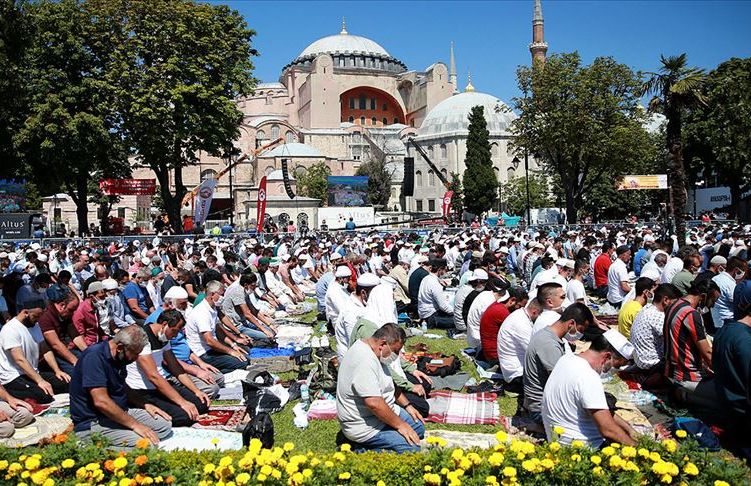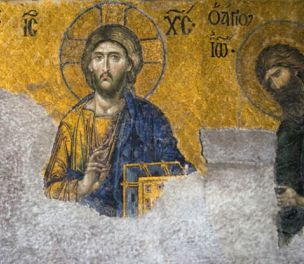(Photo: AA)
Click to read the article in Turkish
Following Hagia Sophia's reconversion to a mosque, Turkey has assured UNESCO of its intention to work with the organization for the protection of the monument, according to Russia's permanent repr to UNESCO.
Ankara promised to invite a delegation of experts to discuss Hagia Sophia's restoration, Alexander Kuznetsov told Russia's state-run TASS agency.
"Permanent Representative of Turkey to UNESCO [Altay Cengizer] circulated a letter addressed to the director-general of the organization, in which he assured that in between Muslim services, the Hagia Sophia will be open to people of all faiths," he said.
CLICK - Kremlin says Hagia Sophia better as a mosque as it will be free to visit
Turkey's Council of State on July 10 annulled a Council of Ministers decree that had turned Hagia Sophia into a museum. On July 24, it reopened as a mosque with a Friday prayer attended by thousands of people.
Hagia Sophia was added to the UNESCO World Heritage List in 1985.
Turkey also promised to establish a scientific committee for restoration and infrastructure projects, Kuznetsov said. "Now they have assured us that they will not do anything without consulting UNESCO specialists and promise to invite the organization's experts to İstanbul in the near future."
"For UNESCO, this is especially important ... because for a long time the Turkish authorities did not respond to the organization's requests and did not consult with it before changing the status of the temple," he explained.
Kuznetsov added that the Turkish authorities sent this letter to UNESCO last week before the reopening. The official could not clarify what additional information UNESCO expects to receive from Turkey.
CLICK - UNESCO: We must be notified of any change in the status of Hagia Sophia
Kuznetsov expressed hope that Turkey, as stated by its UNESCO representative, will strictly observe the provisions of the 1972 Convention on the Protection of World Heritage in relation to the Hagia Sophia.
Hagia Sophia's conversion into a mosqueHagia Sophia was built and served as a church for 916 years until the Ottoman Empire took over İstanbul, and a mosque from 1453 to 1934, and most recently as a museum for 86 years. In 1985, during its time as a museum, Hagia Sophia was added to the UNESCO World Heritage List. On July 10, the Council of State annulled a 1934 cabinet decree that had turned Hagia Sophia into a museum, paving the way for its use again as a mosque. The decision received criticism from the European Union and several countries. On the same day, Hagia Sophia was handed over to the Religious Affairs Directorate by a presidential decree. On July 16, the Religious Affairs Directorate signed a cooperation protocol with the Ministry of Culture and Tourism to run Hagia Sophia after its conversion into a mosque. Under the protocol, the ministry will supervise restoration and conservation work, while the Religious Affairs Directorate will oversee religious services. The architectural treasure will also be open to domestic and foreign tourists free of charge. About Hagia Sophia
Hagia Sophia with its innovative architecture, rich history, religious significance and extraordinary characteristics has been fighting against time for centuries, is the largest Eastern Roman Church in İstanbul. Constructed three times in the same location, it is the world's oldest and fastest-completed cathedral. Today's Hagia Sophia is the third building constructed in the same place with a different architectural understanding than its predecessors. By the order of Emperor Justinianos, it was built by Anthemios from Tralles (Aydin) and Isidoros from Miletos (Balat). The construction started in 532 and was completed in five years and opened for worship in 537 with a great ceremony. When Sultan Mehmet the Conqueror captured the city in 1453, he converted it into his imperial mosque. Known for its Imperial Gate, Beautiful Gate (Splendid Door) and Marble Gate, Hagia Sophia has 104 columns, some of which are brought from ancient cities. The "Omphalion" section where the emperors crowned stands out with marble workmanship like these pillars. Hagia Sophia fascinates people by not only with its architectural design, but also by its gold-plated, silver-plated, glass, terracotta and colored stone mosaics, and the original ceiling mosaics of the 6th century with their floral and geometric motifs. The mosaics with figures following the icon ban in the 8th century especially Mother Mary depicted with child Jesus in her arms, the Archangel Gabriel and the Archangel Michael and Deisis stage mosaics must be seen. Sultan Abdulmecid's Mosaic tughra was built between 1847 and 1849 during the restoration by the Fossati brothers. Eight large round plates that were added during the Ottoman period are the work of famous calligrapher Kadıasker Mustafa İzzet during the reign of Sultan Abdülmecid. Two solid marble cubes in the side aisles, which can receive an average of 1250 liters of liquid, were brought from the ancient city of Bergama during the reign of Sultan Murad III. Source: The Ministry of Culture and Tourism |
(SO/VK)








